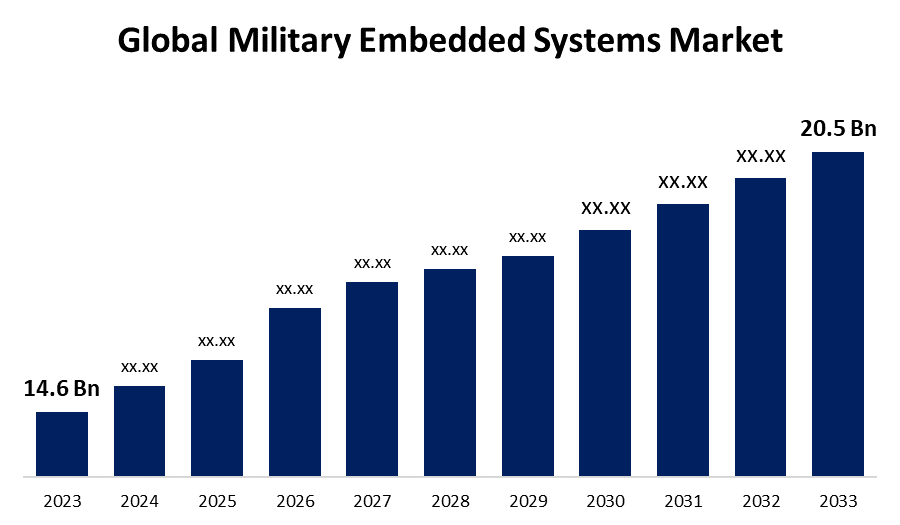Global Military Embedded Systems Market Size To worth USD 20.5 billion by 2033 | CAGR of 3.45%
Category: Aerospace & DefenseGlobal Military Embedded Systems Market worth $20.5 billion by 2033
According to a research report published by Spherical Insights & Consulting, The Global Military Embedded Systems Market Size to grow from USD 14.6 billion in 2023 to USD 20.5 billion by 2033, at a Compound Annual Growth Rate (CAGR) of 3.45% during the forecast period.

Get more details on this report -
Browse key industry insights spread across 230 pages with 127 Market data tables and figures & charts from the report on the "Global Military Embedded Systems Market Size, Share, and COVID-19 Impact Analysis, By Component (Hardware and Software), By Product Type (Advanced Telecom Computing Architecture (TCA), Compact-PCI (CPCI) Boards, Compact-PCI (CPCI) Serial, VME BUS, OPEN VPX, Motherboard ), By Application (Intelligence Surveillance and Reconnaissance (ISR), Command, Control, Communication Navigation, Radar, Avionics, Vetronics, Cyber, Networking), and By Region (North America, Europe, Asia-Pacific, Latin America, Middle East, and Africa), Analysis and Forecast 2023 - 2033." Get Detailed Report Description Here: https://www.sphericalinsights.com/reports/military-embedded-systems-market
The military embedded systems market is experiencing substantial growth, driven by rising defense budgets and technological advancements. These systems, embedded in military platforms for essential functions such as communication, surveillance, navigation, and weapon control, ensure reliability and real-time performance. The increasing demand for more efficient and secure defense solutions, particularly amid growing cybersecurity threats, is a key market driver. Additionally, the shift towards smart and autonomous military technologies, including unmanned aerial vehicles (UAVs) and robotics, is further boosting demand. The integration of cutting-edge technologies like AI, IoT, and 5G is enhancing the versatility and capability of military embedded systems. Government investments in modernization and ongoing geopolitical tensions are also fueling the market's growth and expansion.
Military Embedded Systems Market Value Chain Analysis
The value chain of the military embedded systems market consists of several key stages, starting with research and development (R&D), which is crucial for designing advanced systems tailored to defense needs. Component manufacturers supply essential hardware, including processors, memory, and sensors, which are then integrated by system integrators. These integrators customize the solutions for specific military applications such as communications, navigation, and surveillance. Once developed, the systems undergo rigorous testing for reliability and security in military environments. Afterward, they are deployed on various platforms, including aircraft, naval vessels, and ground vehicles. Following deployment, ongoing maintenance, software updates, and system upgrades ensure continued performance and adaptability. The entire value chain involves close collaboration among defense contractors, technology providers, and government agencies.
Military Embedded Systems Market Opportunity Analysis
The military embedded systems market offers substantial opportunities, driven by technological innovations and evolving defense requirements. Key areas of growth include the integration of AI, machine learning, and autonomous technologies, which improve decision-making and operational effectiveness. The increasing demand for secure communication, data encryption, and real-time analytics creates a lucrative market for embedded systems in cybersecurity and defense communications. Furthermore, the rise of unmanned systems like drones and autonomous vehicles opens new possibilities for embedded solutions in surveillance, reconnaissance, and weaponry. The ongoing focus on modernization initiatives and defense infrastructure upgrades, especially in emerging economies, further enhances market potential. Additionally, the expanding use of 5G and IoT in military operations presents new opportunities for embedded systems. Overall, technological innovation and convergence are creating diverse prospects in this rapidly advancing sector.
Government defense spending is a key factor driving growth in the military embedded systems market. As countries prioritize national security and military modernization, they invest in advanced technologies to strengthen their armed forces' capabilities. This includes upgrading existing systems and deploying new platforms that rely on sophisticated embedded solutions for real-time data processing, secure communications, and autonomous operations. Governments are increasingly focusing on integrating cutting-edge technologies like AI, machine learning, and 5G to enhance operational efficiency and decision-making. Moreover, geopolitical tensions and the growing need for improved defense capabilities are leading to higher military budgets. As defense expenditures rise globally, there is a growing demand for high-performance embedded systems, driving both market expansion and innovation in the sector.
The military embedded systems market faces several challenges that impact its growth. A major issue is the rapid pace of technological change, which demands continuous innovation and updates to keep systems relevant and effective. The complexity of designing secure, reliable, and real-time embedded systems also presents considerable technical obstacles. Furthermore, the increasing interconnectedness of military systems raises cybersecurity concerns, making them more susceptible to cyberattacks. Budget limitations and lengthy procurement processes can slow the adoption of new technologies, while geopolitical tensions and defense regulations complicate international collaboration. Additionally, ensuring interoperability between various military platforms and legacy systems requires significant effort in system integration. Addressing these challenges is crucial for the continued growth and adoption of embedded systems in defense applications.
Insights by Component
The software segment accounted for the largest market share over the forecast period 2023 to 2033. The software segment of the military embedded systems market is growing rapidly, driven by the increasing dependence on advanced software for system performance, security, and functionality. As military platforms become more complex, there is a rising demand for software that supports real-time data processing, secure communications, and autonomous operations. Key trends contributing to this growth include the integration of AI, machine learning, and cybersecurity technologies into embedded software, which improves operational efficiency and safeguards against cyber threats. The software also plays a key role in the development of unmanned systems, drones, and advanced navigation and targeting systems, driving demand across the defense sector. Additionally, the ongoing need for software upgrades, maintenance, and customization ensures a continuous demand for software solutions. As military systems evolve, software innovation is essential for enhancing the capabilities of embedded systems in defense applications.
Insights by Application
The communication navigation segment accounted for the largest market share over the forecast period 2023 to 2033. Military platforms, including aircraft, naval vessels, ground vehicles, and unmanned systems, rely extensively on embedded navigation systems to ensure precision in real-time operations, such as target tracking, route planning, and autonomous movement. The integration of advanced technologies like GPS, inertial navigation systems (INS), and augmented reality (AR) is fueling growth in this segment. Additionally, the increasing focus on improving defense capabilities through advanced navigation solutions for missile systems, drones, and reconnaissance missions is further driving market expansion. As military operations demand greater accuracy and efficiency, the navigation segment is poised for continued growth within the military embedded systems market.
Insights by Product Type
The OPEN VPX segment accounted for the largest market share over the forecast period 2023 to 2033. OPEN VPX, an open-standard architecture, facilitates the integration of modular systems that provide flexibility, reliability, and shorter development cycles, making it well-suited for military platforms such as aircraft, naval vessels, and ground vehicles. The growing demand for faster data processing, real-time communication, and secure operations in complex environments is driving the adoption of OPEN VPX systems. Additionally, the increasing need for interoperability across various military systems and the shift toward software-defined architectures are key factors fueling the growth of this segment. As military applications advance, OPEN VPX offers a cost-effective, future-proof solution to address evolving defense needs.
Insights by Region

Get more details on this report -
North America is anticipated to dominate the Military Embedded Systems Market from 2023 to 2033. As a global leader in defense spending, the United States drives the growth of the region by making substantial investments in military modernization, incorporating embedded systems into various platforms like aircraft, naval vessels, ground vehicles, and drones. The growing demand for secure communications, surveillance, and autonomous systems is accelerating the adoption of advanced technologies such as AI, IoT, and 5G within military applications. Additionally, ongoing defense contracts, research, and development efforts by the U.S. Department of Defense (DoD) and the Canadian Armed Forces further fuel market expansion. North America's strong emphasis on innovation, alongside rising security concerns and military upgrades, positions the region as a prominent player in the global military embedded systems market.
Asia Pacific is witnessing the fastest market growth between 2023 to 2033. China, India, Japan, and South Korea are increasing their defense budgets, driving a higher demand for advanced military solutions. Embedded systems play a vital role in enhancing communication, surveillance, navigation, and autonomous capabilities across defense platforms. The rapid modernization of military infrastructure, with the integration of AI, 5G, and IoT technologies, is propelling market growth. Moreover, ongoing geopolitical tensions and territorial disputes in the region intensify the need for advanced defense systems. The growing use of unmanned systems, drones, and advanced robotics further fuels the demand for embedded technologies. As a result, the Asia-Pacific region is set to become a significant player in the global military embedded systems market.
Recent Market Developments
- In June 2021, Norway purchased five Thales Ground Master 200 Multi-Mission Compact radars (GM200 MM/C) through a government-to-government agreement with the Netherlands. This acquisition equipped the Norwegian Armed Forces with a new mobile artillery locating radar system, designed for use in both national and international operations.
Major players in the market
- Curtiss-Wright Corporation (U.S.)
- Kontron (Germany)
- Xilinx (U.S.)
- Mercury Systems Inc (U.S.)
- EUROTECH (Italy)
- General Dynamics Corporation (U.S.)
- General Micro Systems, Inc (U.S.)
- Advantech Co., Ltd (Taiwan)
- Thales Group (France)
- SMART Embedded Computing (Netherlands)
- NXP Semiconductors (Netherlands)
- Renesas Electronics Corporation (Japan)
- Microsemi (U.S.)
- Advanced Micro Peripherals (U.K.)
- Elma Electronic (Switzerland)
- Texas Instruments Incorporated (U.S.)
- Teledyne (U.S.)
- Intel Corporation (U.S.)
- Radisys (U.S.)
- Aitech (U.S.)
Market Segmentation
This study forecasts revenue at global, regional, and country levels from 2023 to 2033.
Military Embedded Systems Market, Component Analysis
- Hardware
- Software
Military Embedded Systems Market, Product Type Analysis
- Advanced Telecom Computing Architecture (TCA)
- Compact-PCI (CPCI) Boards
- Compact-PCI (CPCI) Serial
- VME BUS
- OPEN VPX
- Motherboard
Military Embedded Systems Market, Application Analysis
- Intelligence Surveillance and Reconnaissance (ISR)
- Command
- Control
- Communication Navigation
- Radar
- Avionics
- Vetronics
- Cyber
- Networking
Military Embedded Systems Market, Regional Analysis
- North America
- US
- Canada
- Mexico
- Europe
- Germany
- Uk
- France
- Italy
- Spain
- Russia
- Rest of Europe
- Asia Pacific
- China
- Japan
- India
- South Korea
- Australia
- Rest of Asia Pacific
- South America
- Brazil
- Argentina
- Rest of South America
- Middle East & Africa
- UAE
- Saudi Arabia
- Qatar
- South Africa
- Rest of the Middle East & Africa
About the Spherical Insights & Consulting
Spherical Insights & Consulting is a market research and consulting firm which provides actionable market research study, quantitative forecasting and trends analysis provides forward-looking insight especially designed for decision makers and aids ROI.
Which is catering to different industry such as financial sectors, industrial sectors, government organizations, universities, non-profits and corporations. The company's mission is to work with businesses to achieve business objectives and maintain strategic improvements.
CONTACT US:
For More Information on Your Target Market, Please Contact Us Below:
Phone: +1 303 800 4326 (the U.S.)
Phone: +91 90289 24100 (APAC)
Email: inquiry@sphericalinsights.com, sales@sphericalinsights.com
Contact Us: https://www.sphericalinsights.com/contact-us
Need help to buy this report?